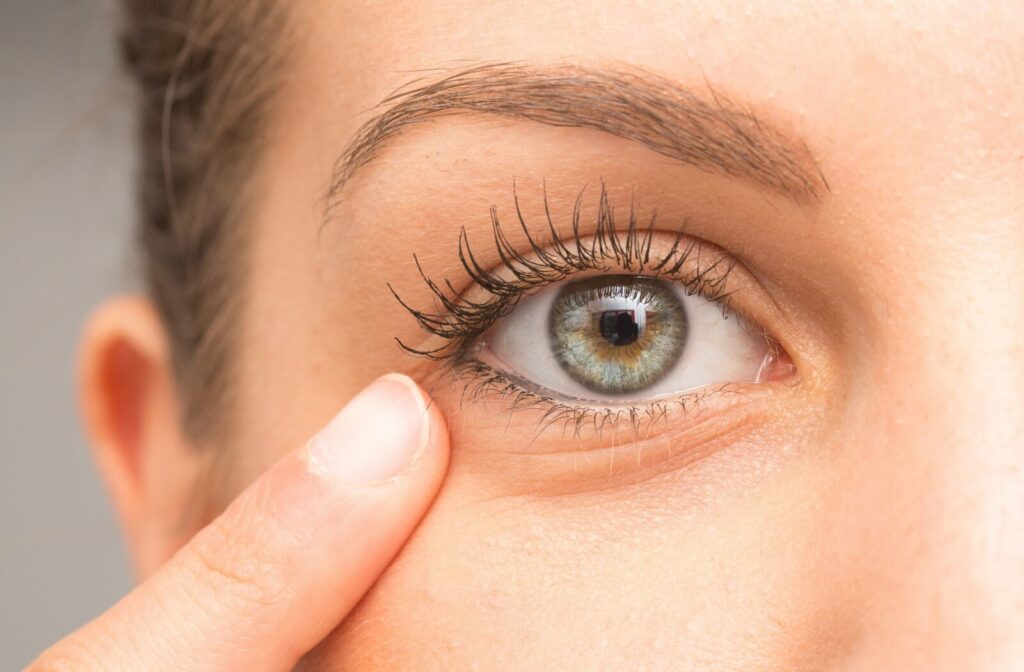As the air gets cooler and drier this winter, you might notice more frequent discomfort in your eyes. At the same time, you may find yourself dealing with nagging headaches, and it’s common to wonder if these 2 conditions are connected. While dry eye does not directly cause headaches, the strain and light sensitivity it creates can trigger tension headaches or migraines.
The relationship between them can be confusing, and having 1 doesn’t guarantee you’ll have the other. Many times, resting your eyes and using over-the-counter (OTC) pain medication are all you need for relief. But you should see your eye doctor for targeted dry eye relief if your symptoms persist despite at-home remedies.
The Link Between Dry Eye and Headaches
When your eyes are not properly lubricated, they have to work harder to focus. This extra effort can strain them and lead to discomfort. The resulting tension can feel very similar to a common headache.
How Eye Strain Causes Discomfort
The constant effort from strained, dry eyes can tire the small muscles in and around them. This fatigue often results in a dull, aching pain around your forehead or temples. For some, specialized lenses like Neurolens can offer relief from this type of recurring strain.
Light Sensitivity and Migraines
Dry eye can make you more sensitive to bright lights, a condition known as photophobia. For anyone who experiences migraines, this sensitivity can be a trigger. It can also make existing migraine symptoms feel more intense.
Why Dry Eye Is Common in Fall and Winter
The change of seasons can be harsh on your eyes. Colder months bring environmental shifts that may increase dry eye symptoms. This increase in symptoms can make related headaches more frequent for many people.
Dry Indoor Air From Heaters
Turning on the heat in your home or office lowers the air humidity. This dry air is a primary reason heat can cause dry eye, as the tear film that protects your eyes evaporates more quickly. Your eyes can then feel irritated and gritty, as disruptions to the tear film are a hallmark of dry eye disease.
Cold, Windy Weather Outdoors
Spending time outside in brisk, windy weather can also strip moisture from the surface of your eyes. This exposure can leave your eyes feeling dry and strained. It contributes to overall discomfort that can lead to tension.
Symptoms and Causes of Dry Eye
Dry eye occurs when your eyes do not produce enough tears to stay moist. It can also happen when your tears are not of the right quality. This condition can lead to a variety of uncomfortable symptoms:
- A scratchy or gritty feeling, like something is in your eye
- Stinging or burning sensations
- Redness and irritation
- Periods of blurry vision
- Sensitivity to light
Factors That Contribute to Dry Eye
Dry eye can have many causes, some common ones include:
- Long hours spent looking at digital screens
- Age and certain life stages
- Some medications, like antihistamines
- Wearing contact lenses, though some contacts work great for dry eye
- Other health conditions

Manage Dry Eye Discomfort at Home
You can take simple steps to find relief from dry eye and the headaches it might trigger. Minor adjustments to your daily routine can make a big difference. These habits can help your eyes feel more comfortable.
Adjust Your Environment
You can use a humidifier to add moisture back into your indoor air. When you go outside, wear protective sunglasses to shield your eyes from wind and sun. These adjustments help prevent tears from evaporating too quickly.
Practice Healthy Screen Habits
Give your eyes regular breaks from screens by following the 20-20-20 rule. Every 20 minutes, look at something 20 feet away for at least 20 seconds. This simple habit can help reduce digital eye strain.
Keep Your Eyes Lubricated
OTC artificial tears can provide temporary relief by adding moisture to your eyes. It also helps to stay hydrated by drinking plenty of water. Staying hydrated supports your body’s natural ability to produce tears.
Explore Personalized Treatments with Us
If you’ve tried managing your symptoms at home but still struggle, it may be time to seek professional care. A thorough eye exam can help identify the source of your discomfort. And your eye doctor can provide personalized recommendations for relieving dry eyes and headaches. These recommendations might include prescription eye drops or lifestyle suggestions.
Finding a solution for your dry, irritated eyes may also bring welcome relief from related headaches. The team at EyeQ Optical is here to help you understand your options. Schedule a visit to discuss your symptoms and move toward clear, comfortable vision.




